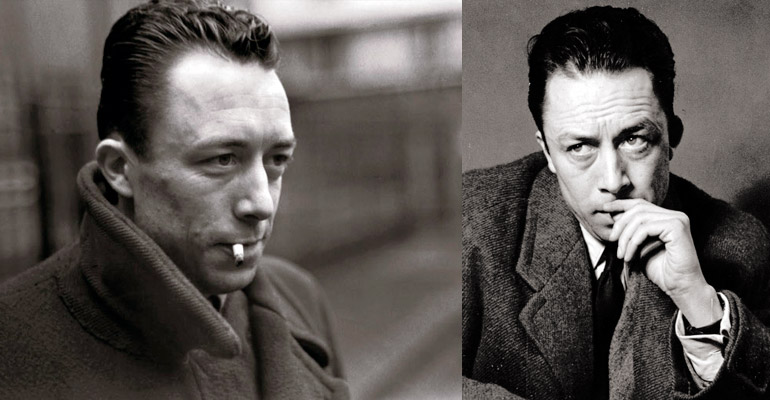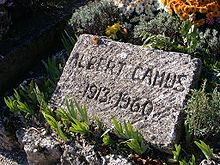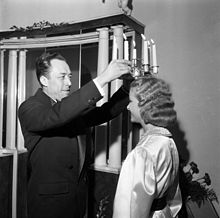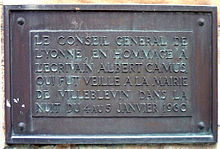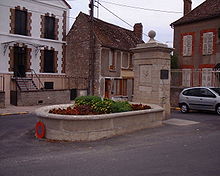Life
Early years
Albert Camus was born on 7 November 1913 in Dréan (then known as Mondovi) in French Algeria.[7] His mother was of Spanish descent and could only hear out of her left ear.[8] His father, Lucien, a poor agricultural worker of Alsatian descent, was wounded in the Battle of the Marne in 1914 during World War I, while serving as a member of the Zouave infantry regiment. Lucien died in a makeshift army hospital from his wounds on October 11.[9] Camus and his mother, an illiterate house cleaner, lived without a wealth of material possessions during his childhood in the Belcourt section of Algiers.
In 1923, Camus was accepted into the Lycée Bugeaud and eventually was admitted to the University of Algiers. After he contracted tuberculosis in 1930, he had to end his football activities; he had been a goalkeeper for a prominent Algerian university team. In addition, he was only able to study part-time. To earn money, he took odd jobs: as a private tutor, car parts clerk, and assistant at the Meteorological Institute. He completed his licence de philosophie (BA) in 1936; in May 1936, he successfully presented his thesis on Plotinus, Rapports de l’hellénisme et du christianisme à travers les oeuvres de Plotin et de saint Augustin (“Relationship of Greek and Christian thought in Plotinus and St. Augustine”),[10] for his diplôme d’études supérieures (roughly equivalent to an MA thesis).
Camus joined the French Communist Party in the spring of 1935, seeing it as a way to “fight inequalities between Europeans and ‘natives’ in Algeria.” He did not suggest he was a Marxist or that he had read Das Kapital, but did write, “We might see communism as a springboard and asceticism that prepares the ground for more spiritual activities.”[5] In 1936, the independence-minded Algerian Communist Party (PCA) was founded. Camus joined the activities of the Algerian People’s Party (Le Parti du Peuple Algérien), which got him into trouble with his Communist party comrades, who in 1937 denounced him as a Trotskyite and expelled from the party. Camus then became associated with the French anarchist movement.
The anarchist André Prudhommeaux first introduced him at a meeting in 1948 of the Cercle des Étudiants Anarchistes (Anarchist Student Circle) as a sympathiser familiar with anarchist thought. Camus wrote for anarchist publications such as Le Libertaire, La révolution Proletarienne, and Solidaridad Obrera (Workers’ Solidarity), the organ of the anarcho-syndicalist CNT (National Confederation of Labor). Camus stood with the anarchists when they expressed support for the uprising of 1953 in East Germany. He again allied with the anarchists in 1956, first in support of the workers’ uprising in Poznań, Poland, and then later in the year with the Hungarian Revolution.
Marriage
In 1934, Camus married Simone Hié, but the marriage ended as a consequence of infidelities on both sides. In 1935, he founded Théâtre du Travail (Worker’s Theatre),[11] renamed Théâtre de l’Equipe (Theatre of the Team) in 1937. It lasted until 1939. From 1937 to 1939 he wrote for a socialist paper, Alger-Républicain. His work included a report on the poor conditions for peasants in Kabylie, which apparently cost him his job. From 1939 to 1940, he briefly wrote for a similar paper, Soir-Republicain. He was rejected by the French army because of his tuberculosis.
In 1940, Camus married Francine Faure, a pianist and mathematician. Although he loved her, he had argued passionately against the institution of marriage, dismissing it as unnatural. Even after Francine gave birth to twins, Catherine and Jean, on 5 September 1945, he continued to joke to friends that he was not cut out for marriage.[12] Camus had numerous affairs, particularly an irregular and eventually public affair with the Spanish-born actress María Casares. In the same year, Camus began to work for Paris-Soir magazine. In the first stage of World War II, during the so-called Phoney War, Camus was a pacifist. While in Lyon during the Wehrmacht occupation, on 15 December 1941, Camus read about the Paris execution of Gabriel Péri;[13] it crystallized his revolt against the Germans. He moved to Bordeaux with the rest of the staff of Paris-Soir. In the same year he finished his first books, The Stranger and The Myth of Sisyphus. He returned briefly to Oran, Algeria, in 1942.
Football
Camus was once asked by his friend Charles Poncet which he preferred, football or the theatre. Camus is said to have replied, “Football, without hesitation.”[14]
Camus played as goalkeeper for Racing Universitaire d’Alger (RUA won both the North African Champions Cup and the North African Cup twice each in the 1930s) junior team from 1928 to 1930.[15][unreliable source?] The sense of team spirit, fraternity, and common purpose appealed to Camus enormously.[16] In match reports Camus would often attract positive comment for playing with passion and courage. Any football ambitions disappeared when he contracted tuberculosis at the age of 17. The affliction, which was then incurable, caused Camus to be bedridden for long and painful periods.
When Camus was asked in the 1950s by an alumni sports magazine for a few words regarding his time with the RUA, his response included the following: “After many years during which I saw many things, what I know most surely about morality and the duty of man I owe to sport and learned it in the RUA.”[14] Camus was referring to a sort of simplistic morality he wrote about in his early essays, the principle of sticking up for your friends, of valuing bravery and fair-play. Camus’s belief was that political and religious authorities try to confuse us with over-complicated moral systems to make things appear more complex than they really are, potentially to serve their own needs.[14]
A professional footballer appears as a character in The Plague and football is discussed in the dialogue.
Revolutionary Union Movement and Europe
As he wrote in L’Homme révolté (The Rebel), in the chapter about “The Thought on Midday”, Camus was a follower of the ancient Greek ‘Solar Tradition’ (la pensée solaire). In 1947–48, he founded the Revolutionary Union Movement (Groupes de liaison internationale – GLI)[5] a trade union movement in the context of revolutionary syndicalism (Syndicalisme révolutionnaire). According to Olivier Todd, in his biography Albert Camus, une vie, it was a group opposed to some tendencies of the Surrealist movement of André Breton. For more, see the book Alfred Rosmer et le mouvement révolutionnaire international by Christian Gras.
His colleagues were Nicolas Lazarévitch, Louis Mercier, Roger Lapeyre, Paul Chauvet, Auguste Largentier, Jean de Boë (see the article: “Nicolas Lazarévitch, Itinéraire d’un syndicaliste révolutionnaire” by Sylvain Boulouque in the review Communisme, n° 61, 2000). His main aim was to express the positive side of surrealism and existentialism, rejecting the negativity and the nihilism of André Breton.
From 1943, Albert Camus had correspondence with Altiero Spinelli who founded the European Federalist Movement in Milan—see Ventotene Manifesto and the book “Unire l’Europa, superare gli stati”, Altiero Spinelli nel Partito d’Azione del Nord Italia e in Francia dal 1944 al 1945-annexed a letter by Altiero Spinelli to Albert Camus.
In 1944, Camus founded the “French Committee for the European Federation” (Comité Français pour la Féderation Européenne – CFFE) declaring that Europe “can only evolve along the path of economic progress, democracy and peace if the nation states become a federation.”
From 22 to 25 March 1945, the first conference of the European Federalist Movement was organised in Paris with the participation of Albert Camus, George Orwell, Emmanuel Mounier, Lewis Mumford, André Philip, Daniel Mayer, François Bondy and Altiero Spinelli.[17] This specific branch of the European Federalist Movement disintegrated in 1957 after Winston Churchill‘s ideas about European integration rose to dominance.
Death
Camus died on January 4, 1960 at the age of 46, in a car accident near Sens, in Le Grand Fossard in the small town of Villeblevin. In his coat pocket was an unused train ticket. He had planned to travel by train with his wife and children, but at the last minute he accepted his publisher’s proposal to travel with him.[18]
The driver of the Facel Vega HK500 car, Michel Gallimard, who was Camus’s publisher and close friend, also died in the accident.[19][20] In August 2011, the Milan newspaper Corriere della Sera reported a theory that the writer had been the victim of a Soviet plot, but Camus’s biographer, Olivier Todd, did not consider it credible.[21] Camus was buried in the Lourmarin Cemetery, Lourmarin, Vaucluse, France.
He was the second-youngest recipient, at the age of 44, of the Nobel Prize in Literature, after Rudyard Kipling, at the age of 42.[22]
He was survived by his wife and twin son and daughter, Jean and Catherine, who hold the copyrights to his work.
Two of Camus’s works were published posthumously. The first, entitled A Happy Death (1970), featured a character named Patrice Mersault, comparable to The Stranger‘s Meursault. There is scholarly debate as to the relationship between the two books. The second was an unfinished novel, The First Man (1995), which Camus was writing before he died. The novel was an autobiographical work about his childhood in Algeria.
Literary career
During the war Camus joined the French Resistance cell Combat, which published an underground newspaper of the same name. This group worked against the Nazis, and in it Camus assumed the nom de guerre Beauchard. Camus became the paper’s editor in 1943. He first met Sartre at the dress rehearsal of Sartre’s play, The Flies, in June 1943.[23]
When the Allies liberated Paris in August 1944, Camus witnessed and reported the last of the fighting. Soon after the event on 6 August 1945, he was one of the few French editors to publicly express opposition and disgust to the United States’ dropping the atomic bombs on Japan. He resigned from Combat in 1947 when it became a commercial paper. After the war, Camus began frequenting the Café de Flore on the Boulevard Saint-Germain in Paris with Sartre and others. He also toured the United States to lecture about French thought. Although he leaned left, politically, his strong criticisms of Communist doctrine did not win him any friends in the Communist parties and eventually alienated Sartre.
In 1949, his tuberculosis returned, whereupon he lived in seclusion for two years. In 1951, he published The Rebel, a philosophical analysis of rebellion and revolution which expressed his rejection of communism. Upsetting many of his colleagues and contemporaries in France, the book brought about the final split with Sartre. The dour reception depressed Camus; he began to translate plays.
Camus’s first significant contribution to philosophy was his idea of the absurd. He saw it as the result of our desire for clarity and meaning within a world and condition that offers neither, which he expressed in The Myth of Sisyphus and incorporated into many of his other works, such as The Stranger and The Plague. Despite his split from his “study partner”, Sartre, Camus was still categorized as an Existentialist. He specifically rejected that label in his essay “Enigma” and elsewhere.[24] The current confusion arises, in part, because many recent applications of existentialism have much in common with many of Camus’s practical ideas (see: Resistance, Rebellion, and Death). But, his personal understanding of the world (e.g., “a benign indifference”, in The Stranger), and every vision he had for its progress (e.g., vanquishing the “adolescent furies” of history and society, in The Rebel) undoubtedly set him apart.
In the 1950s, Camus devoted his efforts to human rights. In 1952, he resigned from his work for UNESCO when the UN accepted Spain as a member under the leadership of General Franco. In 1953, he criticized Soviet methods to crush a workers’ strike in East Berlin. In 1956, he protested against similar methods in Poland (protests in Poznań) and the Soviet repression of the Hungarian revolution in October.
Camus maintained his pacifism and resisted capital punishment anywhere in the world. He wrote an essay against capital punishment in collaboration with Arthur Koestler, the writer, intellectual and founder of the League Against Capital Punishment. He was consistent in his call for non-aggression in Algeria.[25]
When the Algerian War began in 1954, Camus was confronted with a moral dilemma. He identified with the Pieds-Noirs such as his own parents and defended the French government’s actions against the revolt. He argued that the Algerian uprising was an integral part of the ‘new Arab imperialism‘ led by Egypt and an ‘anti-Western’ offensive orchestrated by Russia to ‘encircle Europe’ and ‘isolate the United States’.[26] Although favoring greater Algerian autonomy or even federation, though not full-scale independence, he believed that the Pieds-Noirs and Arabs could co-exist. During the war he advocated a civil truce that would spare the civilians, which was rejected by both sides, who regarded it as foolish. Behind the scenes, he began to work for imprisoned Algerians who faced the death penalty.[27]
From 1955 to 1956, Camus wrote for L’Express. In 1957, he was awarded the Nobel Prize in literature “for his important literary production, which with clear-sighted earnestness illuminates the problems of the human conscience in our times”. When he spoke to students at the University of Stockholm, he defended his apparent inactivity in the Algerian question; he stated that he was worried about what might happen to his mother, who still lived in Algeria. This led to further ostracism by French left-wing intellectuals.
Camus remained active and ambitious until the end of his life. Financed by the money he received with his Nobel Prize, he adapted and directed for the stage Dostoyesvsky’s Demons. The play opened in January 1959 at the Antoine Theatre in Paris. It was a critical success as well as an artistic and technical tour de force: 33 actors, 4 hours long, 7 sets, 24 scenes.[28] The walls could move sideways to reduce the size of each depicted location and the whole stage rotated to allow for immediate set transformations. Camus put the painter and set decorator Mayo, who had already illustrated several of Camus’ novels (The Stranger – 1948 Ed.), in charge of the demanding task of designing these multiple and complex theater sets.[29]
Source wikipedia.org

